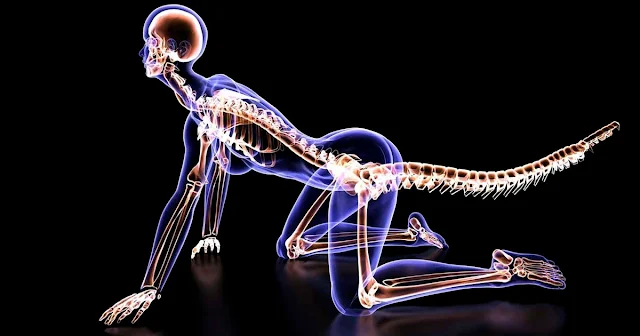One of the most remarkable changes in human evolution is the loss of our tails, a transformation that occurred around 25 million years ago. This pivotal shift not only altered the trajectory of our species but also marked a significant moment in the evolutionary history of primates. While scientists have long speculated on why humans lost their tails, the genetic cause has remained elusive—until now. A recent study published in Nature has finally uncovered the genetic factors responsible for this evolutionary change.

The Quest to Understand Tail Loss
The journey to unravel the mystery of human tail loss began in an unexpected way. Bo Xia, a graduate student at New York University, was inspired to investigate the origins of the human tailbone after injuring his own coccyx. This personal curiosity led Xia and his team to embark on a groundbreaking scientific investigation.
Through careful research, the team focused on the TBXT gene, which plays a crucial role in regulating tail length in various species. Their research revealed a unique genetic mutation within this gene, providing a major breakthrough in understanding human evolution.
The Role of Jumping Genes
A key aspect of this discovery lies in the role of Alu elements, often called “jumping genes.” These genetic elements, specific to primates, can move within the genome and cause significant changes. The researchers found that Alu elements inserted themselves into the TBXT gene, triggering a chain reaction that led to the loss of our tails.
This insertion activated a process known as alternative splicing, where RNA molecules are cut and restructured, which ultimately led to the deletion of a crucial exon. This change altered the structure and function of the resulting protein, leading to the tail loss seen in humans.
Validation Through Mice Studies
To confirm their findings, the researchers engineered laboratory mice with the same genetic mutations found in humans and apes. These genetically altered mice lost their tails, providing compelling evidence that the identified mutation plays a crucial role in the absence of tails in humans and other primates.
However, the study also uncovered a downside to tail loss: an increased risk of neural tube defects, such as spina bifida. This finding highlights the complex balance between evolutionary benefits and potential genetic trade-offs.
The Broader Implications
This discovery has profound implications not just for understanding human evolution, but also for human anatomy and health. The loss of our tails was not a random event but a genetic adaptation with lasting consequences. It illustrates the complex relationship between genetic changes and the way they shape our physiology over time.
As we continue to study our evolutionary past, these findings remind us of the intricate process of natural selection and genetic innovation that has shaped humanity. This breakthrough also underscores the power of scientific inquiry in uncovering the mysteries of our origins, offering insight into the past that can help us understand our future.
The identification of the genetic reasons behind tail loss is a testament to the persistence of scientific exploration and the ongoing quest for knowledge about our evolutionary journey.
Dei dinheiro a uma mulher pobre com um bebê — na manhã seguinte, fiquei chocada ao ver que ela estava fazendo algo no túmulo do meu marido

Quando Rhiannon dá dinheiro a uma mulher desesperada com um bebê do lado de fora de um mercado, ela acredita que é um simples ato de gentileza. Mas na manhã seguinte, ela encontra a mesma mulher no túmulo de seu falecido marido. Enquanto seus mundos colidem, Rhiannon deve confrontar a verdade sobre seu marido.
Você realmente não espera que a vida se desfaça em uma terça-feira. É o tipo de dia que carrega o peso de nada especial, uma parada na semana.
Mas foi exatamente aí que minha vida começou a se abrir, numa terça-feira comum, com os braços cheios de compras e entrando em uma garoa do lado de fora da loja local.

Uma mulher triste sentada perto de uma janela | Fonte: Midjourney
Foi quando eu a vi.
Ela estava sentada no meio-fio, embalando um bebê enrolado em um cobertor azul desbotado. Seu rosto estava pálido e abatido, seus olhos escuros poços de exaustão. Mas havia algo em sua quietude, na maneira como ela se agarrava àquela criança como se ela pudesse flutuar para longe, que me congelou no meio do passo.
“Por favor”, ela murmurou quando passei, sua voz mal se elevando acima do tamborilar da chuva. “Qualquer coisa vai ajudar, senhora.”

Uma mulher sentada com um bebê | Fonte: Midjourney
Eu nunca dou dinheiro a estranhos. É uma regra minha. Digo a mim mesma que é tudo uma questão de ser prática, não cruel. Mas naquele dia, seu apelo me enraizou no lugar. Talvez fosse o rostinho do bebê, redondo e alheio, com olhos grandes demais para seu corpo minúsculo…
Procurei minha carteira e entreguei a ela US$ 50.
“Obrigada”, ela sussurrou, com os lábios tremendo.

Uma mulher segurando sua carteira | Fonte: Midjourney
Eu só esperava que a mulher tirasse aquele garotinho da chuva e o colocasse em algum lugar aquecido. Ele precisava estar seco e seguro.
E era para ser isso. Um ato gentil, um momento fugaz na minha vida. Mas a vida nem sempre fecha os capítulos tão bem, não é?

Um close de um menino | Fonte: Midjourney
Na manhã seguinte, dirigi até o cemitério para visitar o túmulo do meu marido. James tinha partido há quase dois anos. E embora parecesse que o tempo não havia passado, também parecia que décadas haviam se passado.
O acidente de carro me deixou vazio, mas o tempo, cruel e constante, amenizou as arestas mais afiadas da minha dor.
Agora, eu o carregava como um membro fantasma, sempre ali, levemente dolorido. Eu tentava o máximo que podia para seguir em frente com aquela sensação de dor, mas nada conseguia me fazer seguir em frente.

Flores em um túmulo | Fonte: Midjourney
Eu seria para sempre a viúva de James.
Eu gostava de visitá-lo cedo, antes que o mundo acordasse. O silêncio atendia à minha necessidade de ficar sozinha com ele, com minhas memórias dele. Mas naquela manhã, alguém já estava lá.
Dela.
A mulher do estacionamento.

Uma mulher e um bebê em um cemitério | Fonte: Midjourney
Ela estava no túmulo de James, seu bebê equilibrado em seu quadril, colhendo os lírios frescos que eu havia plantado há um tempo. Minha respiração ficou presa enquanto eu a observava deslizar os caules para dentro de um saco plástico.
“O que diabos você está fazendo?”, exclamei.
As palavras saíram de mim antes que eu pudesse detê-las.
Ela se virou, os olhos arregalados de alarme. O bebê pareceu assustado, mas não chorou.

Lírios crescendo de um túmulo em um cemitério | Fonte: Midjourney
“Eu… eu posso explicar”, ela gaguejou.
“Você está roubando flores. Do túmulo do meu marido. Por quê?”, exigi.
Ela piscou para mim como se eu tivesse lhe dado um tapa no rosto.
“Seu marido?”
“Sim!” Eu retruquei. “James. Por que você está aqui?”

Uma mulher em um cemitério | Fonte: Midjourney
Seu rosto se contraiu e ela segurou o bebê com mais força, respirando pesadamente como se estivesse se esforçando para não chorar.
“Eu não sabia… Eu não sabia que ele era seu marido. Eu não sabia que James estava com outra pessoa…”
O ar frio parecia engrossar ao nosso redor. O bebê choramingou.
“Do que você está falando? Com licença? O que diabos você está dizendo?”
Lágrimas brotaram em seus olhos.

Uma mulher chateada em um cemitério | Fonte: Midjourney
“James. James é o pai do meu bebê, senhora.”
O chão abaixo de mim se moveu violentamente e eu tinha certeza de que iria desabar.
“Não”, eu engasguei. “Não, ele não é. Ele não pode ser. Isso é… Não!”
Seus lábios tremeram quando ela assentiu.

Uma mulher chateada | Fonte: Midjourney
“Eu nem cheguei a contar a ele”, ela sussurrou. “Descobri que estava grávida uma semana antes de ele desaparecer da face da Terra. Só soube da morte dele recentemente. Encontrei alguém que nos conhecia, uma mulher do escritório dele. Ela nos apresentou. E ela me contou. Eu nem sabia onde ele estava enterrado até ela me contar. Moramos em cima do supermercado. Em um apartamento minúsculo.”
As palavras dela me atingiram como punhos batendo contra meu corpo. Cada uma parecia mais forte que a anterior. James, meu James, tinha vivido uma vida da qual eu não sabia nada.

Um casal de pé juntos | Fonte: Midjourney
“Você está mentindo”, eu disse, com a voz embargada.
“Gostaria de ser”, ela disse. “Se eu fosse, meu filho teria a possibilidade de conhecer o pai.”
Houve um momento de silêncio antes que ela falasse novamente.

Uma mulher chateada | Fonte: Midjourney
“Ele nunca me falou sobre você. Se eu soubesse…” ela parou. “Olha, eu estava tão brava com ele por nos deixar. Ele me disse que tinha compromissos de trabalho para cumprir e que, quando fosse promovido, voltaria para mim. E quando descobri que estava grávida, fui demitida do trabalho. Tenho contado com minhas economias. Queria que James ajudasse. Mesmo na morte. Pensei que pegar as flores e vendê-las… parece terrível, mas parecia que ele nos devia muito. Sinto muito.”
Por um momento, ficamos ali, olhando um para o outro.

Uma mulher grávida segurando a barriga | Fonte: Midjourney
Eu vi o desespero em seus olhos, a verdade crua que ela carregava em suas mãos trêmulas. E o bebê?
O bebê de James. O mesmo bebê que olhou para mim com olhos grandes e inocentes.
Finalmente, eu falei.
“Fique com as flores”, eu disse, as palavras amargas na minha língua. “Só cuide dele.”

Um close de um menino | Fonte: Midjourney
Seu rosto se contraiu novamente, mas eu me virei e fui embora antes que pudesse ver suas lágrimas.
Naquela noite, eu simplesmente não conseguia dormir. Havia centenas de perguntas passando pela minha mente. Perguntas sem respostas. James tinha ido embora. Não haveria confronto, explicação ou resolução.
Apenas o fantasma dele, agora despedaçado em pedaços que eu não reconheci.

Uma mulher deitada na cama | Fonte: Midjourney
Na terceira noite sem dormir, algo mudou em mim. E o ar ao meu redor parecia diferente.
A raiva meio que diminuiu, deixando apenas uma dor estranha para o bebê. Ele era apenas um garotinho inocente pego na tempestade que seus pais criaram.
Na manhã seguinte, voltei para o cemitério, esperando vê-la novamente. Eu não sabia por que… talvez eu precisasse de provas. Ou talvez eu só quisesse um encerramento.

Uma vista de um cemitério | Fonte: Midjourney
Mas ela não estava lá.
Fui até a casa dela depois disso. Lembrei-me dela dizendo algo sobre morar em um apartamento acima do supermercado local. Só havia um na cidade, então isso resumiu perfeitamente.
Estacionei do lado de fora e olhei para as janelas rachadas, a tinta descascada, e meu estômago revirou. Como ela poderia criar um bebê aqui?

O exterior de um edifício | Fonte: Midjourney
Como James pôde deixá-la viver nessas condições? Ele não se importava mais? O pensamento me deixou doente. Eu já estava lutando contra sua infidelidade, mas isso só fez tudo parecer pior.
Antes que eu percebesse, eu estava entrando no mercado, comprando um carrinho cheio de mantimentos e um urso de pelúcia de uma das vitrines. E então eu subi a escada suja no beco entre dois prédios.

Um close-up de mantimentos | Fonte: Midjourney
Ela atendeu a porta, seu rosto era uma máscara de choque quando me viu.
“Eu não quero nada”, eu disse rapidamente. “Mas eu pensei… que você poderia precisar de ajuda. Para ele.”
Seus olhos estavam cheios de lágrimas, mas ela se afastou, me deixando entrar. O bebê estava deitado em um cobertor no chão, roendo um mordedor. Ele olhou para mim com os olhos de James.

Uma mulher abrindo uma porta | Fonte: Midjourney
Enquanto eu colocava as compras no chão, algo em mim se afrouxou. Talvez James tivesse me traído, sim. E talvez ele tivesse vivido uma mentira. Mas o bebê não era uma mentira.
Essa criança era real e estava aqui.
E de alguma forma, de uma forma que eu ainda não conseguia explicar, ele parecia uma segunda chance.

Um menino em um tapete | Fonte: Midjourney
“Eu sou Rhiannon”, eu disse suavemente, minha voz tremendo. “Qual é o nome dele? E o seu?”
Ela hesitou antes de responder.
“Elliot, e eu sou Pearl”, ela disse.
Sorri, com lágrimas nos olhos.
“Olá, Elliot”, eu disse.

Uma mulher e um bebê | Fonte: Midjourney
Ele piscou para mim e, pela primeira vez em dois anos, o peso da tristeza no meu peito diminuiu, só um pouco.
“Não sei o que isso significa”, eu disse cuidadosamente, olhando entre ela e o bebê. “Mas não acho que nenhum de nós dois consiga fazer isso sozinho.”
Os lábios de Pearl se separaram, como se ela quisesse dizer algo, mas as palavras ficaram presas em sua garganta. Em vez disso, ela assentiu.

Uma mulher sentada em um sofá | Fonte: Midjourney
Elliot gorgolejou, alheio à tempestade que nos trouxera até ali. Peguei sua mãozinha, e ele agarrou meu dedo com uma força surpreendente. Uma risada escapou de mim, repentina e desprotegida.
Naquele momento, percebi que a traição de James não era a história toda. Sua ausência nos conectou, duas mulheres ligadas pela perda, pelo amor, pelo legado confuso e complicado de um homem que nós duas conhecemos de maneiras diferentes.
Eu não sabia se o perdão era possível.
Eu não sabia se queria isso.
Mas eu sabia de uma coisa: eu tinha encontrado um motivo para continuar.

Uma mulher sorridente | Fonte: Midjourney
Carol, seu marido, Rob, e seu filho Jamie têm uma rotina de sábado de recados e guloseimas. Conforme o dia se desenrola, tudo acontece exatamente como Carol planejou. Até que eles chegam a uma loja de tecidos, onde Carol procura material para fazer a fantasia de Halloween de Jamie, apenas para descobrir segredos que ela não sabia que estavam na fundação de sua família. Ela é deixada tentando pegar os fios da tristeza que ela não sabia que tinha.
Este trabalho é inspirado em eventos e pessoas reais, mas foi ficcionalizado para fins criativos. Nomes, personagens e detalhes foram alterados para proteger a privacidade e melhorar a narrativa. Qualquer semelhança com pessoas reais, vivas ou mortas, ou eventos reais é mera coincidência e não intencional do autor.
O autor e a editora não fazem nenhuma reivindicação quanto à precisão dos eventos ou à representação dos personagens e não são responsáveis por nenhuma interpretação errônea. Esta história é fornecida “como está”, e quaisquer opiniões expressas são as dos personagens e não refletem as opiniões do autor ou da editora.



Leave a Reply